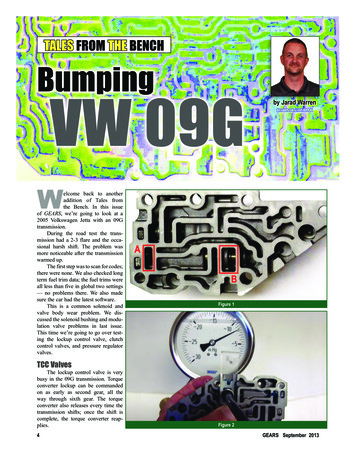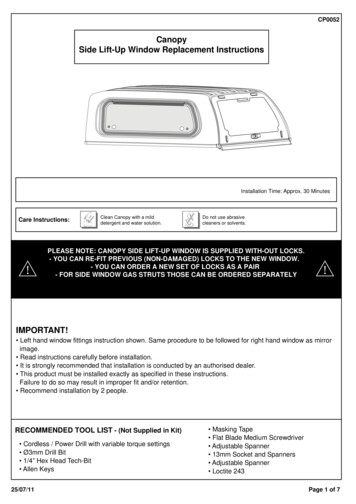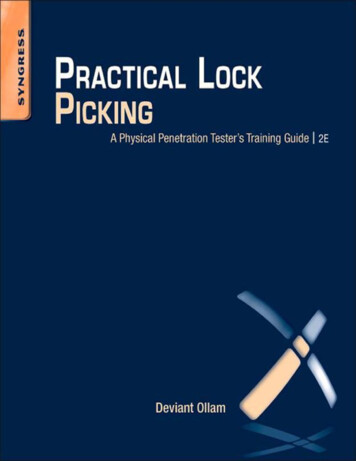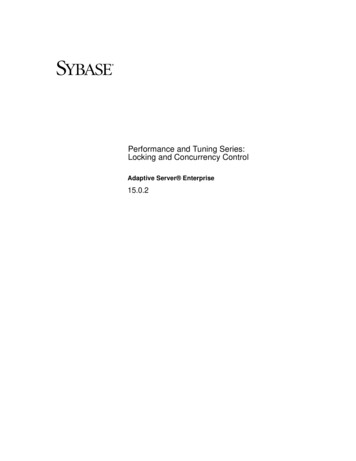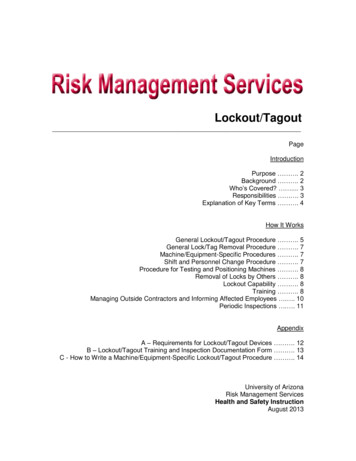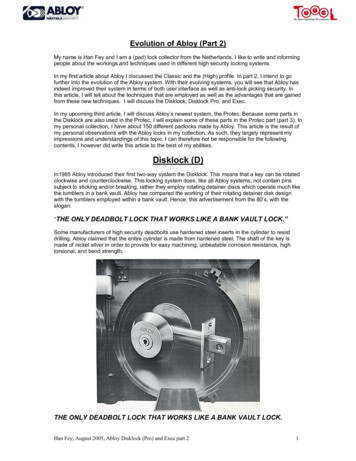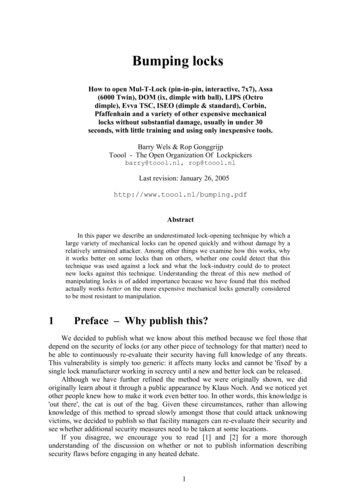
Transcription
Bumping locksHow to open Mul-T-Lock (pin-in-pin, interactive, 7x7), Assa(6000 Twin), DOM (ix, dimple with ball), LIPS (Octrodimple), Evva TSC, ISEO (dimple & standard), Corbin,Pfaffenhain and a variety of other expensive mechanicallocks without substantial damage, usually in under 30seconds, with little training and using only inexpensive tools.Barry Wels & Rop GonggrijpToool - The Open Organization Of Lockpickersbarry@toool.nl, rop@toool.nlLast revision: January 26, 2005http://www.toool.nl/bumping.pdfAbstractIn this paper we describe an underestimated lock-opening technique by which alarge variety of mechanical locks can be opened quickly and without damage by arelatively untrained attacker. Among other things we examine how this works, whyit works better on some locks than on others, whether one could detect that thistechnique was used against a lock and what the lock-industry could do to protectnew locks against this technique. Understanding the threat of this new method ofmanipulating locks is of added importance because we have found that this methodactually works better on the more expensive mechanical locks generally consideredto be most resistant to manipulation.1Preface – Why publish this?We decided to publish what we know about this method because we feel those thatdepend on the security of locks (or any other piece of technology for that matter) need tobe able to continuously re-evaluate their security having full knowledge of any threats.This vulnerability is simply too generic: it affects many locks and cannot be 'fixed' by asingle lock manufacturer working in secrecy until a new and better lock can be released.Although we have further refined the method we were originally shown, we didoriginally learn about it through a public appearance by Klaus Noch. And we noticed yetother people knew how to make it work even better too. In other words, this knowledge is'out there', the cat is out of the bag. Given these circumstances, rather than allowingknowledge of this method to spread slowly amongst those that could attack unknowingvictims, we decided to publish so that facility managers can re-evaluate their security andsee whether additional security measures need to be taken at some locations.If you disagree, we encourage you to read [1] and [2] for a more thoroughunderstanding of the discussion on whether or not to publish information describingsecurity flaws before engaging in any heated debate.1
2Introduction to locks and lock security2.1How locks workPin tumbler locks, from the cheapest to the most expensive all work in roughly thesame way. The key slides down the keyway in the inner cylinder of the lock. As it moves,the cuts in the key move stacks of two or more pins, moving in holes drilled through theouter and inner cylinder. Small springs behind these pins push the pins back after a highpoint on the key has passed. When the correct key is all the way in and the 'shoulder' ofthe key rests against the inner cylinder, all the gaps between the pins inside the lock alignon the 'sheer line', and the inner cylinder is free to turn.Photos courtesy of Matt BlazeThe picture above shows a 'cut-away' version of a simple pin tumbler lock with thecorrect key inserted. For a much more thorough introduction to the inner workings oflocks, please refer to [3].2.2Picking locksLock can be 'picked'. A skilled operator can use tools to feel and move individualpins in the lock. Lockpicking allows one to open a lock by exploiting the fact that the pinstacks are never perfectly aligned. This causes some pins to be stuck between the innerand outer cylinder before others. Because of this, one can feel that certain pins arecorrectly aligned before all the pins are aligned. And because the outer pins that wouldjam before others will remain on the outside of the inner cylinder after the lock is turnedslightly, one can successively place the pins in the correct position and open the lock.Lockpicking takes quite a bit of practice. Apart from intelligence professionals,criminals and locksmiths practicing it, lockpicking has become a regular sport, completewith official clubs and championships1. Lock manufacturers have defended new locksagainst picking by inserting so-called 'mushroom pins', by making keyways narrower(providing less space for tools) and by lowering the mechanical tolerances of the lockmanufacturing process. (See picture of EVVA lock on page 7)Going over the details of locks and lock picking would be outside of the scope of thispaper. Please refer to the "MIT Guide to Lock Picking" [3] if any of the above is unclear.1Ssdev (Sportsfreunde der Sperrtechnik Deutschland eV) in Germany and Toool (The OpenOrganization Of Lockpickers) in The Netherlands.2
2.3The snapper pick, lockpick gun and vibrating toolsAnother means of opening locks without the key is by using a snapper pick, lockpickgun or vibrating tool. These devices all exploit Newton's law that says that for everyaction there is an equal and opposite reaction. Most people are familiar with Newton'scradle, a device which is often used to demonstrate this law.If a ball all the way on the left or right side is lifted up and let loose to collide withthe row of suspended balls, this ball will transfer all itsenergy to the next ball and so forth, until the ball on theother end moves to swing away from the other balls.When it swings back, the process is reversed and theoriginal ball swings up. The same principle can beobserved during a game of billiards: one ball hitsanother one, and this ball continues onward whereasthe first ball now lies still.This principle can be used to open locks: ifimpulse energy is transferred to the first pin, it willtend to stay in place and the second pin tends to moveaway from the first one, until the spring stops it andpushes it back to touch the first pin.A 'lockpick gun' such as the one shown below will, when the trigger is pulled,tension a spring and then when the trigger is pulled all the way use the force of thatspring to snap the needle up for a short distance, but with a very sharp and powerfulmotion. By positioning this needle into the lock, just touching the pins, and then pullingthe trigger, one tries to hit all the pins simultaneously. By then making the lock turn inthe split-second before all the upper pins are pushed back by the springs in the lock, onecan open the lock. The amount of turning force and the timing with which to apply itrequire some training.Vibrating picks use the same principle except many times a second, requiring lesstraining on the part of the operator. A snapper pick is the simpler version of a pick gun.The lock industry has created locks that are more resistant to this technique. Moreresistant locks have narrower keyways, preventing tools from being inserted in the firstplace, and making it harder to transfer the impulse energy to the pins. More resistantlocks also have smaller tolerances, creating less space for the pins to bounce around.lockpick gun2snapper pick32In this case a special gun, made by Kurt Zuhlke. The head on this gun can be reversed to snap eitherup or down, allowing picking of 'European style' locks where the pins are pushed up by the springs.3Image taken with permission from "Locks, safes, and security" [4], page 5783
3Bumping locks3.1HistoryBumping, sometimes also called 'Rapping', has been a known technique for at leastthe past 50 years. A bump key is described in Marc Tobias's reference work "Locks,Safes, and Security" [4] on page 603. Few people use the technique, and the method doesnot seem successful against a large number of locks unless the 'minimal motion method'described below is used. Once correctly used, we found this technique to be immenselypowerful, allowing a large variety of locks to be opened. We did not invent thistechnique, and others probably thought of some of the same refinements we did. We dofeel bumping is underestimated, and this paper exists to point to its effectiveness.3.2Principle & Bump keysSo we have a basic trick to open a lock by making the second pin jump away fromthe first, but no efficient means to apply this energy to the bottom pin. As it turns out, thebest way to transfer energy to the pins is using a key. First of all, we need a 'bump key'for the lock in question. A bump key is a key in which all the cuts are at maximum depth.The picture below shows bump keys for various locks. Bump keys are sometimes called'999' keys because all cuts are at maximum (9) depth.As you can see you can cut bump keys for both regular pin tumbler locks as well asfor 'dimple locks', whether 'pin-in-pin' or not. Just remember to take away all the materialthat could be taken away by the deepest combination for that position.There are machines that will cut a key based on the numbers that represent the depthat each position. Having access to such a machine speeds up the process of creating abump key that has the cuts in the exact right position, although one can also use a file anda steady hand to create one. Bump keys, once cut, can be copied on regular key-cuttingequipment. You do not necessarily need to have an uncut key (called 'blank') to make abump key: because all the cuts of a bump key are at maximum depth, any used key for agiven lock can be converted into a bump key.4
3.3The pull-back methodNow there are different methods for using such a bump key to transfer force to thepins inside the lock. When we first learned of the method, we were told to first insert thekey all the way, and then pull it back one pin. Then, hit the back of the key (the partwhere you normally hold on to it) with a solid object such as a hammer, and then turn thekey a split-second later. We found the exact timing for the turning of the lock to becritical, requiring quite a bit of practice. While this method worked on some locks, it didnot work on a great many others. Among other problems: when keys had very deep cuts,the trick tended to not work either because the pins would still be pushed in too far by theparts of the bump key between the deepest points.3.4The minimal-movement methodNormally, if you insert a key all the way into thelock, the pins inside the lock touch the deepest point ofthe cut in the key at the point where the shoulder of thekey makes contact with the inner cylinder of the lock. Byfiling a tiny bit of metal off both the tip and the shoulderof the key, we can create a bump key that can go just alittle bit deeper into the lock. When such a bump key isinserted all the way into the lock, it will be pushed outagain a tiny bit by the force of the springs inside the lock,until the pins again rest on the deepest point in the keycuts. We found filing off between 0.25 and 0.5 mm worksbest, but you may wish to experiment for the best results.We found it is very easy to take off too much. Allyou need to do is make sure that when the key is in all theway, the pins touch the sides of the cuts instead of thebottoms. Seeing the key be pushed back a fraction of amillimeter by the springs in the lock means you have filedaway enough material from the shoulder.Bump key. Note that tip andshoulder are not yet modified.Now that we have our bump key, weneed to hit the back of the key withsomething that applies the right amountof impulse power, without having somuch weight that it would damage thebump key or the lock. We use a specialbumping tool built by Kurt Zühlke calledthe Tomahawk, but anything with nottoo much weight and preferably alsosome swing, such as a dull bread-knifeheld by the blade or the handle of ahammer could also work.5
A picture showing the gap betweenthe lock and the shoulder of a'minimal movement' bump key.The bumping of a lock using the 'Tomahawk'.Some keys do not have a shoulder: such is the case with the Mul-T-Lock keys. Inthis case, the depth of the keyway determines how far one can insert the key. To create abump key, one would theoretically only need to cut off a bit from the end of the key.However, the end of the key and the insides of the lock were found to be too fragile towithstand the repeated hammering while we were trying to open the lock.Oliver Diederichsen came up with an innovative way of making sure the keywouldn't go too deep. Take off a piece at the end to allow for the key to go further in, andthen cut a glue stick in two, and glue the twohalf-round pieces to the key after heatingthem enough to melt a bit of the glue.In some cases, most notably with somedimple key locks, the force needed is smallenough that one can hold the bump key backbetween one's fingers: no need for glue oranything else.3.5Multi-principle locksSome locks employ two different principles, such as the Assa Twin 6000. This is avery secure lock, and one of our former favorites. One part of the lock is a regular pintumbler mechanism, while another part is a sidebar mechanism. Although bumping willsuccessfully attack the pin tumblerpart, the sidebar mechanism holds.Unfortunately, it looks like most Twin6000's sold in a certain region have thesame sidebar, to allow for locksmithsto store pre-cut sidebar blanks forcopying. If this is the case, one couldsimply cut a bump key out of any keywith the correct sidebar for a region.44By the way: did we mention we collect sidebar profiles of the Assa Twin? If you have a key, pleasemail a detailed picture of it, complete with the region where you bought the key, to barry@toool.nl6
3.6ProblemsIt is very easy to damage the lock and/or the bump key using any bumping method.The force needed to transfer enough impact energy to the pins can cause the shoulder ofthe key to make a dent on the front of the inner cylinder, as shown below. The photo ofthe LIPS OCTRO bump key shown to the right shows the result of the forces on theshoulder, and also shows damage to the dimples from repeated bumping.More seriously, bumping can cause minordeformations, causing the bump key to get stuck in thelock. Usually extra force when pulling it out helps toremove the bump key, but in some cases it can get verystuck.The bump key should be made out of the hardestmetal available: softer metals will quickly deform at theshoulder, causing the bump key to go too deep and notwork. We predict a large market for hardened steel bumpkeys for the popular high-security cylinders. Also, somelocks where the inner cylinder is made out of softermetals can be damaged quite easily by the shoulder of thebump key.3.7Refinements & IdeasOne could envision a way to clamp the key between two pieces of metal, possiblyattached to a small rubber block thattouches the lock. This way one couldhit the key without impacting the lockin the same damaging way theshoulder of the bump key does. Therubber would be chosen such that itwould deform only by the fraction of amillimeter needed for bumping towork. Shown is Jort Knaap's solutionfor a Mul-T-Lock Interactive, built out of two nylon washers and a piece of hard rubberwhich we have found to completely prevent denting.For the time being, putting either a thick rubber band such as used in the postalsystem or a tie-wrap between the shoulder and the lock seems to prevent or diminishdenting. (White tie-wraps seem to be the toughest, and one can tie it though the key-ringhole on the key to keep it in place.)7
4Expensive locksWe've noticed during our experiments that the more expensive a lock was, the betterthis method worked. Bumping works on some high-end locks we never thought could bemanipulated easily, and can be very hard or impossible to get to work on veryinexpensive locks. There are a number of reasons for this. First of all the more expensivelocks are made out of harder metal, causing less deformations on impact. Then expensivelocks also have tighter tolerances, allowing for smoother motion of the parts inside.The fact that some of these locks have narrower keyways that block normal toolsdoesn't bother us: our bump key doesn't need more room than the normal key. In fact: thesmoother everything is, the less of the impact force is wasted.So it looks like everything that used to make a lock 'good' works in favor of thismethod, but we suspect a large number of less expensive pin tumbler locks to also bevulnerable. We have either bumped or personally witnessed the bumping of the followinglocks (in no particular order): Assa Twin 6000Mul-T-Lock pin-in-pinMul-T-Lock interactiveMul-T-Lock 7x7LIPS OctroLIPS KesoDOM IX KGDOM 5-pinEVVA TSCZeiss IKON 5-pinCorbin 5-pinICEO dimpleD.L.C. 5-pinLince dimpleABUS 5-pinPfaffenhainGEGE AP3000VachetteCodemImportant disclaimer: please note that the above list does not mean to imply thatevery cylinder of a named brand and type will open readily using bumping. Locks areexpensive and we are not a commercial testing lab, so we have had only a very limitednumber of testing locks available to us. The presence of a lock in the above list justmeans bumping worked on at least once on a cylinder that we had access to. To us thismeans that type of lock is at least suspect, and further research is needed. Also, it is veryprobable that a great many locks not on this list are vulnerable too. Also note that wehave seen locks that bump open quite easily a number of times, and then for some reasonbecome very hard to bump, even though the regular key still works.8
5ForensicsLock forensics is, among other things, the science behind knowing whether a lockwas opened using manipulation. Lockpicking, for instance, often leaves tiny scratces onthe pins in places where the regular key would not scratch. The first sign that a lock wasbumped is the dent made on the outside of the inner cylinder by the shoulder of the bumpkey. But as previously discussed, there are ways to make sure this denting doesn't occur,and in some cases, such as the Mul-T-Lock bump key we’ve shown, no dents will bemade on the outside. Also beware that both older and softer (cheaper) locks will have adent there even if they were never bumped.Looking at the pins on the inside of a bumped lock compared to pins from a lock thatwasn't bumped showed no differences that could be detected by the naked eye or by usinga magnifying glass. It could well be that differences can be found under a microscope.We lack the basic metallurgic knowledge, the forensic experience and the necessaryequipment to say anything conclusive about the pins we examined.Given that the insertion of a bump key isn't much different from inserting a regularkey, we'd suspect no special scratch marks would be found other than maybe someminiature dents and deformations caused by the impacts. Until more is known, we think itis diligent to assume that any lock that can be bumped can also, with some care, bebumped without leaving any telltale traces.6ConclusionsThe perfect lock does not exist. With enough training, tools and time, almost anylock can be manipulated. Practical security is almost always a trade-off between the costof the lock and the time and effort needed for an attacker to open the lock. However: interms of mechanical lock security, we believe that this vulnerability exposes afundamental flaw in a large number of existing mechanical lock designs. Resistanceagainst this attack will have to be incorporated in all future high-end locks, and judgingby their own design criteria a large number of high-end locks seen today must beconsidered flawed.6.1Re-evaluating facility securityIf your present security depends on one or more mechanical locks presently thoughtto be very resistant to manipulation, you should at least investigate whether these lockscan be bumped. Manufacturer claims as to how manipulation-resistant a certain lock isshould be considered worthless unless the claim specifically mentions resistance tobumping.If you employ a type of lock that can be bumped and your security criteria do notallow for a lock that can be opened by unskilled attackers in 30 seconds then you shouldreplace the locks in question.In instances where security is of the utmost importance, you may wish to implementextra security measures assuming even high-end mechanical locks can be opened in muchless time than previously assumed. Employing a number of different high-end locks for agiven entry may add additional security.The fact that a lock has a keyway-shape for which blanks are not generally availableoffers little protection: devices exist that can create a blank when given a key, or even a9
picture of the outside of the lock. Also note that one does not need a blank to cut a bumpkey: any key will do.This may be a good time to consider deploying electronic locks and electromechanical opening mechanisms.6.2Locks that resist bumpingThere are mechanisms that do not allow for the two pins to separate except when slidsideways, such as used in the Emhart interlocking lock (which is not being producedanymore). As far as we can see, such a mechanism would successfully foil the bumpingattack. Also some mechanisms which have a one-piece locking mechanism (such as a'sidebar') may resist bumping5. Locks that involve rotating discs (such as Abloy Protec)or magnets (such as Evva MCS and Anker) are also not susceptible to this attack6.Klaus Noch sells modified standard Euro profile locks which lock up (i.e. 'broken butclosed') upon most attempted manipulations, including bumping. [5]7AcknowledgementsThe authors wish to thank Walter Belgers, Matt Blaze, Manfred Bölker, Kim Bohnet,Paul Boven, Django Bijlsma, Paul Crouwel, Oliver Diederichsen, Han Fey, Julian Hardt,Jiemme, Jord Knaap, Klaus Noch, Marcel van der Peijl, Marc Tobias, Rob Zomer andKurt Zühlke and all the other people from Toool and Ssdev for their input on this topicand/or for energizing discussion on the security of locks in general. In addition, theauthors wish to thank Matt Blaze, Paul Boven and Marc Tobias for permission to useillustrations.5Unless the sidebar combination is known, such as is the case with the Assa Twin 6000 where thesame sidebar seems used for many locks sold in a certain region.6Bumping could still be used to attack a pin tumbler portion of a multi-principle lock.10
References[1]Matt Blaze, On the discussion of security ]Paul Clark, Full Disclosure Debate sclosure-by-date.html[3]Theodore T. Tool, MIT Guide to Lock Picking, 1991,http://www.toool.nl/mit.pdf[4]M.W. Tobias, Locks, safes and security (second edition), 2000,ISBN 0-398-07079-2[5]Klaus Noch, http://semtechnologie.de/technik.htm11
training on the part of the operator. A snapper pick is the simpler version of a pick gun. The lock industry has created locks that are more resistant to this technique. More resistant locks have narrower keyways, preventing tools from being inserted in the first place, and making it harder t
